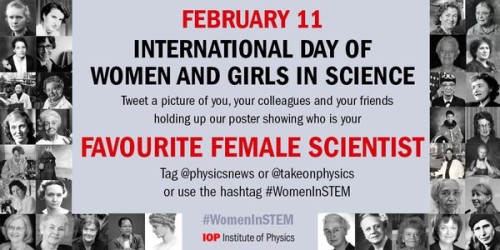
By James Dacey
Tomorrow is the inaugural International Day of Women and Girls in Science as declared by the United Nations (UN). It’s a chance to celebrate women’s achievements in science, technology engineering and mathematics (STEM), and to address the under-representation and inequality that women and girls face in many STEM fields.
One way you can take part on the day is to write the name of your favourite female scientist on this printable poster. Take a photo of yourself holding the poster and share it on Twitter including #WomenInSTEM. This social-media initiative is the idea of our colleagues at the Institute of Physics, which publishes Physics World, who have lots of information about their ongoing diversity programmes on their website. I’ll be sharing the name of Mary Somerville, the Scottish polymath who predicted the existence of Neptune.
Officially announced in December, the international day is part of the UN’s drive towards achieving its recently adopted 2030 Agenda for Sustainable Development. Gender equality and the empowerment of women and girls are among the key goals the UN is working towards. As well as promoting human rights, the focus on STEM education and employment also offers clear economic benefits to developing nations.
“An International Day for Women and Girls in Science will add prestige to the scientific achievements within the UN system, in national contexts, in universities and non-governmental organizations, and the private sector,” says Princess Dr Nisreen El-Hashemite, executive director of the Royal Academy of Science International Trust (RASIT).
On the day itself, RASIT will be co-hosting a forum at the UN’s New York headquarters where speakers will include 11-year-old “future neuroscientist” Rebecca Jekogian. Meanwhile, starting at 1 p.m. GMT SciDev.Net will be running a live two-hour Twitter debate on women in STEM with a panel including Tonya Blowers, Coordinator of the Organization for Women in Science for the Developing World (OWSD).
Find out more about the day here. Also look out for the March issue of Physics World, a special issue about making physics a more inclusive discipline for all.
Lynn Margulis
Jocelyn Bell Burnell
Tough question; there’s so many excellent choices. Basically since she comes to mind, having been in the news a lot lately, and does great work, Lisa Randall. And historically how about Emmy Noether.
Lisa Randall
Books:
Dark Matter and the Dinosaurs
Higgs Discovery
From the LIGO collaboration: Gabriela Gonzalez
I’ll vote for Marie Tharp who first mapped the great under-ocean mountain ranges and found the canyons in them that led to the acceptance of plate tectonics. She was what we would now call a research parasite who combined earthquake data, undersea soundings and a host of other data to create the now familiar charts of the ocean’s depths. She was the first to recognize the Pacific Ocean’s “ring of fire” and the true nature of them mid-Atlantic rift. She did not get on well with her boss at Lamont, but she managed to completely change our view of the world.
Marie Curie
Barbara MacLintock.
Trackback: » Top female scientists